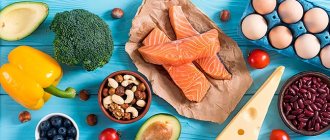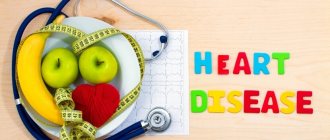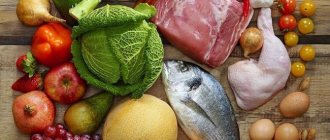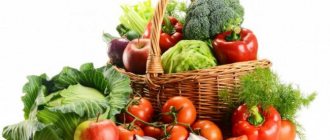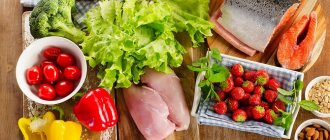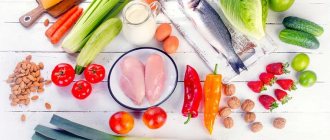January 14, 2011
How is nutrition structured for weight loss in case of obesity, what food should you give up, and what should be left for normal functioning of the body.
It is necessary to fight excess weight. It not only makes a person unattractive, but is a serious risk factor for the development of a huge number of diseases. Including such poorly treatable and potentially fatal ones as heart attack with stroke or even cancerous tumors. However, even if you are truly overweight, the choice of diet for weight loss must be taken very responsibly. The common belief that in order to lose excess weight it is enough to eat almost nothing for a while or even go hungry is a misconception. After all, the goal is not only to lose weight, but also not to harm your health.
How is a diet designed for obesity?
Overweight or obese?
Obesity is usually diagnosed with a body mass index (BMI) of 30 or more. You can find out your BMI yourself using our calculator. And what other formulas there are for determining a healthy weight are described in a special material.
Many diets have been developed for the treatment of obesity, but the main principle of traditional diet therapy is a sharp reduction in calorie intake, proportional to excess of normal body weight. This indicator is calculated individually for each nutritionist’s client, but usually with severe excess weight, the number of calories is reduced by an average of 40 percent of the daily energy requirement.
FRIDAY
Breakfast: buckwheat porridge
Lunch: soup with bell pepper and carrots; steamed chicken soufflé with carrots in a slow cooker
Afternoon snack: cottage cheese casserole without eggs
Dinner: salad with couscous and shrimp
Nutritionist's comment:You can supplement buckwheat porridge with fresh herbs and grated cheese. |
Basic principles for losing weight:
1. Reducing the calorie content
of the diet to 1800 kcal and below, calculated by a specialist based on the person’s initial weight.
2. Limiting fast carbohydrates in the menu - especially sugar and white flour products (pasta, pastries, white bread) - the main suppliers of energy
that are easily stored in fat.
3. Limit animal fats
by 50 percent.
But this does not mean that the diet becomes fat-free. Animal fats in the diet are replaced by vegetable fats, which can activate the process of the body using up its own fat reserves. 4. Creating a feeling of satiety
by increasing the proportion of low-calorie but high-volume foods in the diet - raw vegetables, fruits, whole grain products.
5. Small meals - up to six times a day
- help fight hunger.
The daily ration is simply divided into six equal parts, which are eaten at regular intervals. 6. Refusal of
foods that stimulate the appetite - spices, herbs, savory snacks, smoked meats and pickles.
7. Limiting the amount of salt to five g per day and normalizing the drinking regime
- up to 1.5 liters per day, mainly clean drinking water.
SATURDAY
Breakfast: cottage cheese casserole without eggs
Lunch: soup with bell pepper and carrots; steamed chicken soufflé with carrots in a slow cooker
Afternoon snack: blueberry smoothie with oatmeal
Dinner: trout with vegetables in the oven
Nutritionist's comment:Soup with bell peppers and carrots - especially for those who think that vegetables are boring! |
Therapeutic diet
When treating obesity, nutritionists usually use diet No. 8
, the calorie content of which they can increase or decrease by eliminating certain foods in the diet.
| Products | It is forbidden | Can |
| Bread | White, all baked goods | Black, protein - up to 150 g per day |
| Soups | Meat, fish and mushroom, all strong broths | Soups based on vegetable broths, weak broths made from lean meat |
| Meat | Pork, goose, duck, lamb, fatty chickens, all smoked meats and sausages | Lean beef, rabbit, fat-free chicken, boiled or stewed |
| Fish | All fatty varieties, smoked or fried | Low-fat boiled or steamed fish, seafood |
| Vegetables | Potatoes, beets, carrots and other vegetables with a high glycemic index | Cabbage, leafy vegetables, radishes, cucumbers, tomatoes, greens - raw or baked, seaweed |
| Cereals, legumes, pasta | Pasta | Cereals, beans or lentils as sources of essential amino acids - instead of bread. |
| Egg dishes | Fried omelettes or fried eggs | Boiled, steamed |
| Dairy | Hard cheeses, margarine, sour cream, full-fat milk and cream | Low-fat milk, kefir, yogurt, cottage cheese |
| Fruits | Sweet fruits with a high glycemic index | Sour and sweet and sour varieties of fruits and berries up to 200 g per day |
| Beverages | Compotes, jellies and nectars with sugar, sweet soda, sweet juices | Coffee or tea without milk and sugar, juices from sour fruits and berries, mineral water |
| Fats | Lard, margarine, spreads | Butter and vegetable oils - 20 g per day only for cooking |
MONDAY
Breakfast: millet porridge with pumpkin
Lunch: beetroot soup; meatballs with buckwheat (1-2 pieces will be enough)
Afternoon snack: baked apples with cottage cheese
Dinner: salmon with lemon in paper + vegetables of your choice
Nutritionist's comment:Porridge is an ideal breakfast dish. In the morning, our body needs carbohydrates; they will provide energy for the first half of the day and give strength. And pumpkin will enrich your breakfast with vitamins, it is especially rich in vitamin A. Lunch should be varied; it is one of the key meals. Include vegetables, meat, and grains in your lunch. Even during the period of weight loss, you should not forget about desserts. Let them be light and definitely healthy - apples with cottage cheese are a great option. As a side dish for dinner, I would offer fresh vegetables - lettuce, cherry tomatoes and sweet peppers. Or you can steam vegetables, cauliflower or broccoli are suitable. Red fish is an excellent source of Omega-3 fatty acids; they are necessary for the visual organs, the central nervous system and help reduce “bad” blood cholesterol. |
What to remember
Treatment of obesity involves a low-calorie diet combined with exercise.
Despite the fact that when losing weight you have to give up many foods, your diet must contain a sufficient amount of protein, fat and foods containing a lot of fiber. For individual recommendations, it is best to contact a nutritionist. Tags:
- Diets
- Diet
- Overweight
- Weight loss
- Therapeutic diets
• To leave a comment you must be an authorized user
- Usavel Fitness Sweets are the most popular variety of healthy probiotic candies. The most useful of all types. There are 2 types: with goji berries and with blueberries. In addition to the indisputable fact that these berries are extremely beneficial for the whole body, fitness fruits are also created to strengthen the immune system and prevent dysbacteriosis, and also contain stevioside, which is the most useful of all sugar substitutes. Suitable for adults: dietary food (does not contain sugar and fat), diabetic nutrition, sports nutrition (has a restorative effect when playing sports). If you are interested in our products, then you can find out more on the website: biosynergy[dot]ru or call by phone (calls within the Russian Federation are free)
- Usavel Immunofets are no less useful probiotic candies for immunity and the prevention of dysbiosis; in addition, they contain fructose, which is sweeter than sugar, but does not have the harmful effects of sugar. There are seven types: strawberry, raspberry, blueberry, blackcurrant, cherry, lime and milk flavor. Suitable for children and adults who have restrictions on sugar intake, and those who are on various diets and dream of sweets.
- Usavel In our opinion, the best solution is a combination of sweets and healthy supplements. Children and adults, when eating candy, additionally receive beneficial bifidobacteria and lactobacilli, as well as microelements to increase the body's immunity. We present to you a line of healthy food products - “Biofet”, “Immunofet”, “Fitnessfet” containing probiotics and extracts of delicious and healthy berries and fruits. Biofets are healthy probiotic candies that strengthen the immune system and are also used to prevent dysbacteriosis. The product line includes three types: banana, blueberry and milk flavor. Suitable for children and adults who want to strengthen their immunity and not think about dysbiosis while consuming delicious sweets.
- Usavel Healthy candies for the whole family! How often do you remember to eat healthy? We all think about eating healthy, but don't stick to it because it may not taste as good as other less healthy foods that fill grocery store shelves. Parents often think that they should feed their children healthy food to avoid health problems in the future. After all, we all know about the dangers of food that we buy for the joy of children. But the whole problem lies in the small range of products, high cost and poor taste.
- kurashko I have been on many diets, but the most optimal ones, where the weight really goes away, are the fermented milk diet, the Mayo Clinic diet... and count calories... the most important thing is to drink vitamins
- efremenko Eat less and most importantly exercise.
WEDNESDAY
Breakfast: Frittata with zucchini, spinach and tomatoes
Lunch: hake soup; cabbage salad with tomatoes
Afternoon snack: kefir with banana, ginger and cinnamon
Dinner: homemade turkey sausages + peppers, stewed with tomatoes
Nutritionist's comment:Try to use a variety of vegetables in your menu. The more varied your diet, the more different vitamins and microelements it contains. If for lunch you use a hearty soup containing meat, poultry or fish (as we did in this case), then for the second it is better to choose a vegetable dish, for example, a salad. Ginger increases heat exchange, thereby helping to accelerate metabolic processes. And cinnamon helps reduce cravings for sweets, so you should use it regularly during weight loss. Sweet peppers contain B vitamins, ascorbic acid and provitamin A - beta-carotene. |
SUNDAY
Breakfast: couscous with pumpkin and cranberries in a slow cooker
Lunch: vegetable puree soup; Mexican stuffed bell peppers in the oven (in this recipe I recommend replacing pork with beef)
Afternoon snack: green smoothie
Dinner: trout with vegetables in the oven
The menu for obesity was compiled taking into account the principles of the “Menu of the Week” system.


